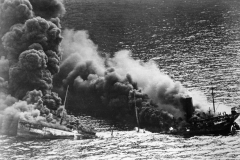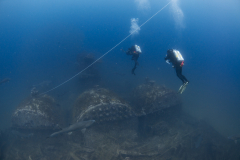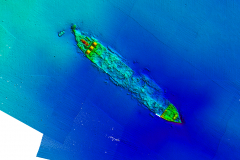Just off coastal North Carolina lies the Graveyard of the Atlantic. This World War II battlefield serves as the final resting place for nearly 1,700 men. From January to July 1942, German U-boats sank dozens of Allied and merchant vessels off Cape Hatteras with relative ease. This year, Scuba Diver Life and NOAA will partner to profile 12 different ships in the Graveyard of the Atlantic. We’ll begin with a visit to the Dixie Arrow.
The Dixie Arrow sinks
At sunrise on March 26, 1942, a German U-boat, U-71 was prowling off North Carolina’s coast when it spotted a merchant tanker near the Diamond Shoals Light Buoy. The tanker, Dixie Arrow, was carrying more than 86,000 barrels of crude oil, destined for Paulsboro, New Jersey, when U-71 fired two torpedoes that slammed into its starboard side. In less than a minute, the tanker was fatally damaged and engulfed in flames. The crew had no warning and was unprepared for the attack.
A third torpedo hit, sending flames even higher, and all but one lifeboat was lost. On duty in the wheelhouse, able seaman Oscar Chappel jumped into action. Standing his post, he brought the ship into the wind, which kept the flames of the burning fuel away from the men trapped at the bow. This gave them time to escape using the one lifeboat and a raft. However, in doing so, the flames enveloped his wheelhouse and he died. As a result of Chappel’s heroic efforts, 22 of the 33-man crew survived, and he posthumously received the Distinguished Merchant Marine Medal.
Diving the Dixie Arrow
Today, the Dixie Arrow rests in 90 feet (27 m) of water just 15 miles south of Hatteras Inlet. The wreck is a popular dive site, offering divers an opportunity to not only view an historic shipwreck, but also an abundance of marine life. Covered in baitfish, with amberjacks swimming throughout, the wreck teems with a variety of fish and corals. The curious sand-tiger shark is one of the site’s most popular visitors.
In addition to marine life, divers can also investigate the remains of the Dixie Arrow, which sits upright, contiguous from bow to stern. The main features are at the bow and stern areas. The bow section includes portions of its stem, which rises up 30 feet (9 m), and sections of the forward deck and outer hull structure. Inside the bow’s starboard side you will find its chain locker, including two large chain piles, and hawse pipes. Smaller machinery pieces, such as the windlass and cargo pumps are also at the bow. The intact, but collapsing, steel hull sits upright on its keel.
Near the middle of the wreck, Dixie Arrow’s remains have mostly collapsed inside the hull. Some deck beams, bulkheads, and cargo tank wall sections are in place. The tanker’s keel is visible in areas where the rest of the hull components are missing.
At the stern, the boilers and engine are among the most prominent pieces. The triple-expansion steam engine provides the highest relief for the site. On both sides of the engine are the scattered machinery remains, including pipes, valves and fittings of all size and description. Although mostly buried in the sand, the propeller is still discernable.
As with other World War II shipwrecks, the Dixie Arrow is a war grave for 11 crewmen, so be sure to leaving the wreck and its artifacts intact for future generations. Learn more about the Dixie Arrow here.
An expanded sanctuary
In an effort to honor the service and sacrifice of those lost during the Battle of the Atlantic, NOAA in 2019 will release a draft proposal to expand the boundaries of Monitor National Marine Sanctuary to include a nationally significant collection of shipwrecks that currently have little or no legal protection. The expansion would also establish the largest area designated as a World War II battlefield anywhere in the world.
To learn more about the proposal, click here.






